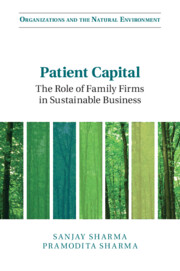Book contents
- Patient Capital
- Organizations and the Natural Environment
- Patient Capital
- Copyright page
- Contents
- Figures
- Tables
- Preface
- 1 Definitions
- 2 Primary Data: Cases from the Winery Industry in Canada, France, and Chile
- 3 Exogenous Drivers of Corporate Environmental Sustainability Strategy
- 4 Organizational Drivers of Corporate Environmental Sustainability Strategy
- 5 Managerial Drivers of Environmental Sustainability Strategy
- 6 Bringing the Family into the Corporate Environmental Sustainability Strategy: Implications for Research, Education, and Policy
- Index
- References
6 - Bringing the Family into the Corporate Environmental Sustainability Strategy: Implications for Research, Education, and Policy
Published online by Cambridge University Press: 12 July 2019
- Patient Capital
- Organizations and the Natural Environment
- Patient Capital
- Copyright page
- Contents
- Figures
- Tables
- Preface
- 1 Definitions
- 2 Primary Data: Cases from the Winery Industry in Canada, France, and Chile
- 3 Exogenous Drivers of Corporate Environmental Sustainability Strategy
- 4 Organizational Drivers of Corporate Environmental Sustainability Strategy
- 5 Managerial Drivers of Environmental Sustainability Strategy
- 6 Bringing the Family into the Corporate Environmental Sustainability Strategy: Implications for Research, Education, and Policy
- Index
- References
Summary
This chapter pulls together the discussions in the monograph and summarizes and categorizes all the research propositions developed in the previous chapters. It then demarcates the charateristics that are unique to family firms and those that are more likely in family firms in making such firms have a greater propensity to undertake patient long-term investments in developing proactive environmental strategies. It then deveops a framework showing how appying the family business lens changes what we know about drivers and influences of proactive environmental strategy and how non-family firms can learn from family firms to undertake patient capital investments in addressing sustainability challenges. The chapter concludes with avenues for future research and measure development, for business education, and for public policy.
Keywords
- Type
- Chapter
- Information
- Patient CapitalThe Role of Family Firms in Sustainable Business, pp. 195 - 232Publisher: Cambridge University PressPrint publication year: 2019

